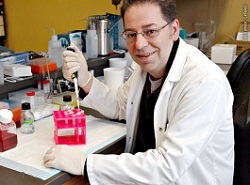 |
| André Marette, scientific director of Université Laval's Institute of Nutrition and Functional Foods--Courtesy of Université Laval |
A naturally occurring molecule that mimics some of the effects of physical exercise could be used to treat insulin resistance and Type 2 diabetes, according to Canadian researchers.
The findings, published May 11 in Nature Medicine, could eventually lead to a treatment for the millions of people with Type 2 diabetes or even a preventive for the disease, rates of which continue to increase with obesity on the rise in developed countries. Insulin resistance is often a precursor to Type 2 diabetes or prediabetes, in which the body produces insulin but does not use it effectively, leading to the buildup of glucose in the blood instead.
Researchers at Quebec's Université Laval, the Quebec Heart and Lung Institute Research Center, and Canada's Institute of Nutrition and Functional Foods have discovered a molecule, a derivative of omega-3 fatty acids, that seems to regulate blood glucose in the same way as exercise does naturally.
Scientists have known that omega-3 fatty acids can help reduce insulin resistance caused by a diet high in saturated fat. In previous research, study author André Marette, scientific director of Université Laval's Institute of Nutrition and Functional Foods, and his colleagues linked these effects to a naturally occurring lipid called protectin D1. Further research showed that another member of the same family--called protectin DX, or PDX--spurs the production and release of interleukin 6, or IL-6, in muscle cells, a response that also occurs during exercise.
"Once in the bloodstream, IL-6 controls glucose levels in two ways: it signals to the liver to reduce glucose production and acts directly on the muscles to increase glucose uptake," Marette said in a statement.
To establish this connection between PDX and IL-6, Marette and his team studied transgenic mice lacking the IL-6 gene. They found that in these mice, PDX had very little effect on the control of blood glucose. But in similar tests in obese diabetic rats, PDX triggered IL-6 secretion in the muscles, leading to dramatically improved responsiveness to insulin, the hormone that regulates blood glucose.
Marette plans to test PDX's antidiabetic effects in humans but warns that the molecule is not a substitute for physical exercise.
- see the study abstract
- read the press release